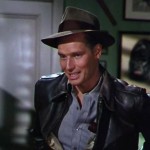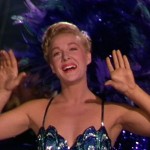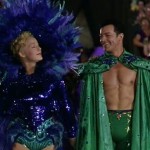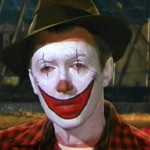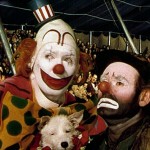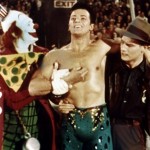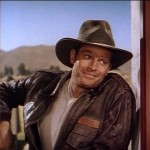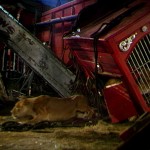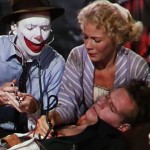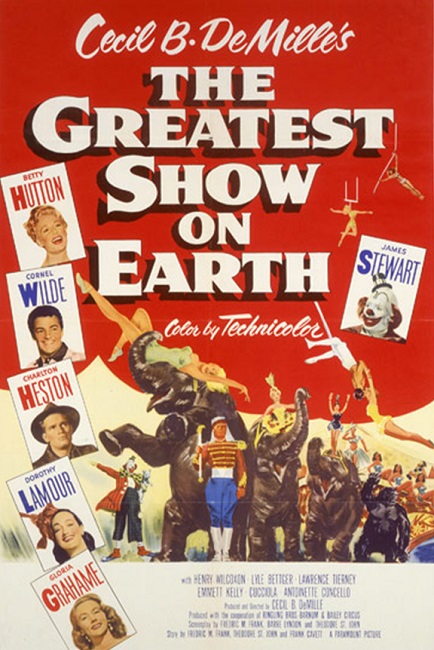
The Greatest Show on Earth – 1952
Who doesn’t love the circus? Well, that is what this Best picture winner was about, plain and simple. The movie tried to tell the real story of Ringling Brothers and Barnum & Bailey Circus, both in the spotlight and out of it. But they attempted to do it by writing a fictional story, tailor made by Hollywood, that involved both the public and private lives of the performers and the manager. The research I did indicated that many critics consider this film to be one of the least deserving Best Picture winners. Not having seen its competition, I can’t say for sure whether that is true or not. All I can do is compare it to the other winners I’ve seen and see how it measures up.
My opinion is divided. In some respects, it seemed a bit too frivolous and shallow to deserve the award. The plot seemed a little too contrived and the subject matter to juvenile. However, in other ways, it had a grand scale and a subtle self-importance about it that made me feel the opposite. There was a certain amount of gravitas, and possibly even pathos, centered on the big-top that made me feel for the characters. You see, these people’s lives revolved around their work: the circus. They had the innate need to perform dangerous and even death-defying stunts for the approval of the screaming crowds.
And why not the circus? Technicolor films were finally starting to take hold in Hollywood and there is no arena that is more colorful, bright, and glitzy. The movie was like a kaleidoscope of bold and beautiful glamour. It was a true sparkling, Technicolor spectacle. In that respect, this is what previous Best Picture winner The Great Ziegfeld would have done if it had the chance. The plot was no more shallow than It Happened One Night or Broadway Melody of 1929. It had a touch of fantasy and a touch of reality, just like Gone With the Wind, or Casablanca. If these films won, then why not The Greatest Show on Earth?
And this film had a few other tricks up its sleeve: Charlton Heston for one, and James Stewart for another. Heston played Brad Braden, the circus manager. He is the guy that lives, eats, and breathes circus. He knows and cares for all the 1,400 circus employees and is the real engine behind the big show. He is the hirer and the firer. He makes all the big decisions except for the money, though he is portrayed as persuasive enough to get what he wants when it comes to that. But being that obsessed with his job has its drawbacks when he is romantically involved with Holly, the beautiful trapeze artist played by Betty Hutton. In order to draw the crowds needed to keep the show going, Brad hires another trapeze artist named Sebastian, played by Cornel Wilde. Unfortunately for Holly, this pushes her out of the center ring. Thus, we have the plot’s main conflict.
Then we had James Stewart playing the part of Buttons the Clown. To me, his was a much more interesting story line, though in the context of the film, it was only a sub-plot. Buttons wore his clown make-up all the time whether he was performing or not. But it wasn’t because he was quirky or trying to “stay in character”. It is established early on in the film that he is secretly hiding from something, though we don’t learn until almost the end what he is hiding from. I thought Stewart did a great job, both as a clown, and as a man with a dark secret in his past. The moments when he was not performing his clown act, there was a seriousness about him that was very interesting to see through the happy, comical make-up.
The film’s climactic sequence was, in my opinion, incredibly well done. The circus train crashed. The train wreck scene was very well done and exciting to watch. It caught me off guard and I didn’t see it coming. The “bad guys” got their just desserts, though the tragedy threatened to close the show. Fortunately, the circus is portrayed as an industry that deals with hardship on a regular basis and always comes up smiling for the crowds. They are depicted as a rare and special breed of folk who have a history of taking their lumps and being able to greet their audiences with the unquenchable merriment that is expected of them. They are survivors. Despite losing half their acts in the phenomenal accident, they get right back up and draw in the spectators to watch The Greatest Show on Earth!
But even putting all that aside, I enjoyed the movie simply because it was the circus. They actually used Ringling Brothers and Barnum & Bailey Circus to make up the cast of extras. Actual circus performers got to do their acts for the cameras. The acrobats were thrilling, the performing animals were exotic and amazing, the clowns were funny, and the pageantry parades were dazzling. The film does a great job of capturing the excitement of going to the circus. That part of the movie was fun to watch. Just the sheer volume of the circus acts they were able to fit into the film made it worth watching.
However, in my research, I found that many critics consider this movie to be the worst of the Best Picture winners. So I have to ask the question: Why did it win? Some say that it was because the Director, Cecil B. DeMille was a supporter of Senator Joseph McCarthy. McCarthy, at the time, was pursuing Communists, and Carl Foreman, who was a producer of the main competition for the Best Picture award, High Noon, was soon to be on the Hollywood Blacklist. Thus it was a political decision.
But there was another reason that sounded just as plausible. This was the Academy’s last chance to vote for Cecil B. DeMille, to honor him for a lifetime of film making going well back into the silent movie era. The members of the Academy (which included many veterans of the silent era) felt that as an elder statesman of Hollywood, he deserved the honor even if films like The Quiet Man, High Noon, Singin’ in the Rain, and Ivanhoe were seen as better movies.
For me, it was the movie’s contrived plot that was its ultimate failing. The acting was passable, the stand-outs, of course, being Heston and Stewart. But I found myself not caring who ended up with whom at the end. Like I mentioned earlier, the sub-plot centered around Buttons the Clown was more interesting to me than the main plot. (Unfortunately, the character’s back-story was never fully explained.) But that’s not to say that I didn’t enjoy the film. I think Leonard Maltin summed it up pretty well in 1999: “Like most of DeMille’s films, this may not be art, but it was hugely enjoyable.”
